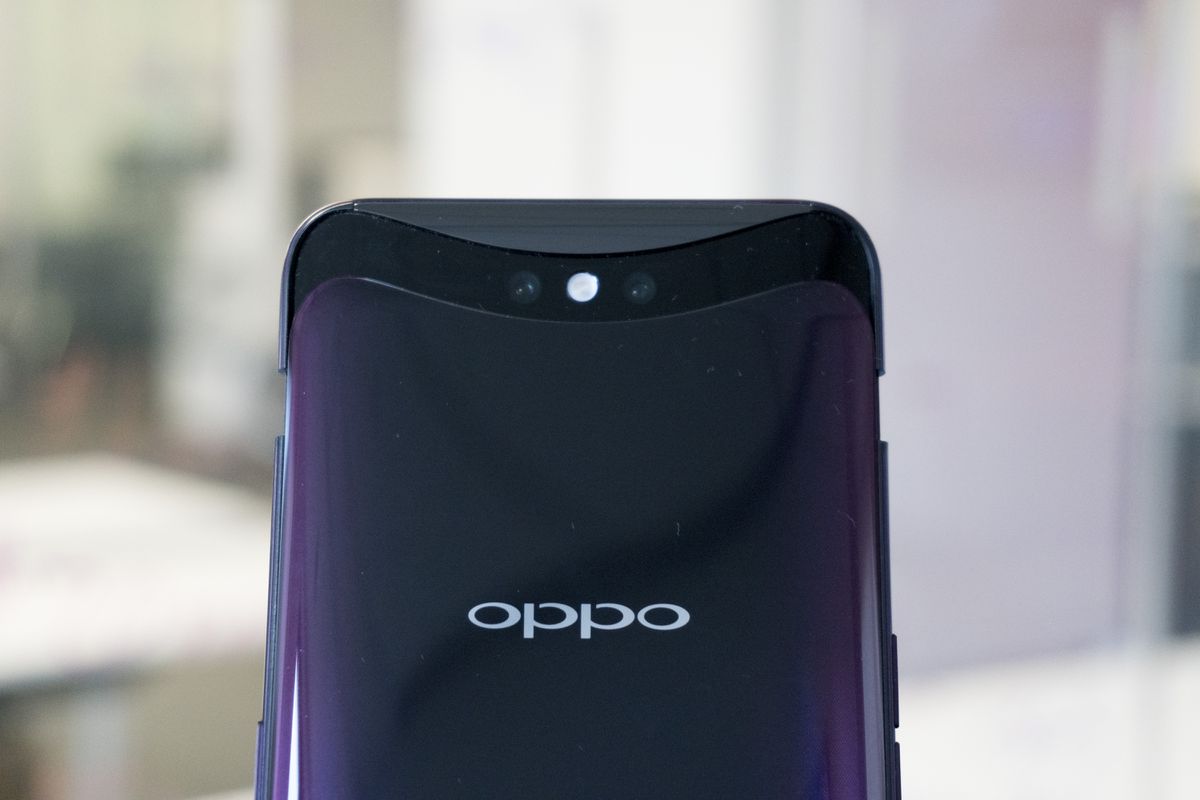Technology
The all-screen phone of the future is finally here

Highest screen-to-body ratio on any phone to date • Futuristic sliding camera module • Super fast face recognition • High-quality metal and glass body • Long battery life
Not available in the U.S. • Doesn’t work with Verizon or Sprint • Average camera image quality • No wireless charging • No IP water rating • Really pricey
The Oppo Find X is the all-screen phone of tomorrow, available today, if you’re willing to pay for it.
It came from the future like the Terminator. Actually, it didn’t, but the Oppo Find X sure makes a statement every single time I whip it out.
The Oppo Find X might look like every other glass-and-metal phone released this year, but I can promise you’ve never seen any phone with a show-stopping feature like its motorized top that extends and retracts to reveal the front and back cameras. Nor will you find a phone with a screen that covers as much of the front without a notch.
I’d be lying if I said I wasn’t envious of all the innovative Chinese phones that have been released recently.
While Apple and Samsung continue to play it mostly safe with iterative updates — bigger and sharper screens, faster performance, and mildly better cameras — China’s homegrown phone makers like Huawei, Vivo, and Oppo are jumping off the deep end with head-turning features.
Huawei’s P20 Pro is the first phone with three rear cameras. Vivo’s NEX S is the first phone with an in-display fingerprint reader and a selfie camera that pops up and collapses into the body.
And now Oppo’s delivering the phone of our dreams with the Find X, a gorgeous slab of glass that’s virtually all screen and comes with a motorized camera system.
It’s so futuristic, so techie, and so, so expensive. The Oppo Find X will cost €999 (about $1,165 USD) when it launches in Europe in August. The phone’s already available in Asia.
Americans are screwed once again. Oppo confirmed it has no plans to release the Find X in the U.S. If you really want one, you’ll have to import it. And even if you do, it’ll only work on GSM networks like AT&T or T-Mobile. CDMA networks like Verizon and Sprint are a no-go.
Sliver from the future
Look at that shimmer.
Image: RAYMOND WONG/MASHABLE
There are glass-and-metal phones, and then there’s the Find X. It’s not a groundbreaking new design — it’s clearly inspired by Samsung’s Galaxy phones and their signature curved glass edges that spill into the metal frame — but the phone does look and feel pretty damn sweet.
Some of my friends and colleagues weren’t into the “Bordeaux Red” version of my review unit, which has a purple metal frame with a Corning Gorilla 5 glass back that’s mostly black and color shifts to shades of pink, purple, and red at the sides, but I think it’s really unique. There’s also a “Glacier Blue” colorway, which shifts to blue instead of pink.
Just from looking at its color, there’s no mistaking the Find X for an iPhone or Samsung Galaxy. The striking glass finish is unlike any phone out there.
It’s really great to see companies breaking out of the mold of boring solid colors and experimenting with different gradients and textures for phones with glass backs.
The Find X is practically all screen.
Image: RAYMOND WONG/MASHABLE
The polished glass is slippery and the phone’s one of the thicker ones (9.6mm or 0.37 inches), but the curves and tapers make it easier to front-pocket than the Pixel 2 XL, which is about the same size.
There are a couple concessions on the Find X, which feel unforgivable given its $1,000+ price. There’s no wireless charging despite the back being glass. Most egregious is the lack of NFC so no Google Pay; the Find X only supports Alipay Face Payment using its face recognition system (more on that in a bit), but I wasn’t able to test that in the U.S.
There’s also no IP-rated water or dust-resistance; the phone can withstand light splashes of water like rain, but not submersions.
The Find X supports dual nano SIM cards, but there’s no microSD card slot for storage expansion. Though, 256GB of storage is probably more than enough.
You won’t find a headphone jack, either. I’m less bothered by this because there’s a pair of wired USB-C earbuds included in the box and a headphone.
No headphone jack, but at least there’s a pair of USB-C earbuds in the box.
Image: RAYMOND WONG/MASHABLE
The phone’s also only got a mono speaker, which I think is unacceptable on such a pricey device. Oppo does deserve credit for giving the bottom of the metal frame a concave shape — a deliberate design choice that doesn’t muffle the audio as much when you cover the speaker with your hand.
However, sound quality is not great, often sounding tinny and distorted, especially at high volumes. You can also feel the speaker rattle if you place your hand near it.
All-screen without a notch
This. Is. It. The Oppo Find X is the all-screen — truly all screen without any notch — we’ve all been dreaming of.
Well, mostly.
Though there’s no notch, the phone does come with a very slender “chin” below the display, which is barely thicker than the bezels around the top and sides of the screen. It’s one of the thinnest “chins” on any phone.
Oh em gee. Dat screen.
Image: RAYMOND WONG/MASHABLE
All considered, the Find X’s screen has a whopping 93.8 percent screen-to-body ratio — the highest on any phone — and is the closest any production phone’s ever gotten to being an entire pane of glass. The only phone we know of with a higher screen-to-body ratio is Vivo Apex’s, which clocks in at 98 percent, but it doesn’t count because it’s only a concept device.
To put the Oppo Find X’s ridiculous full screen design into perspective, here’s how the competition stacks up:
-
iPhone X: 82.9 percent (notch)
-
Galaxy S9: 83.6 percent (forehead and chin)
-
OnePlus 6: 83.8 percent (notch and chin)
-
Essential Phone: 84.9 percent (notch and chin)
-
Huawei P20 Pro: 82 percent (notch and chin)
-
LG G7 ThinQ: 82.6 percent (notch and chin)
-
Pixel 2 XL: 76.4 percent (forehead and chin)
-
Vivo NEX S: 86 percent (notch and chin)
Oppo was able to achieve such a glorious screen by pushing the earpiece all the way to the tippy top bezel and hiding the front-facing camera and various sensors (like the proximity sensor) inside of what it simply dubs the “sliding module.”
This sliding module is far more sophisticated than the motorized selfie camera on Vivo’s NEX S. It pulls double duty, revealing and concealing not just the front camera and sensor system, but also the rear dual cameras as well.
The screen really is magnificent. The 6.4-inch OLED screen (2,304 x 1,080) doesn’t have the highest resolution, but it’s still really good. It’s bright, colors are rich and pop, and the viewing angles are wide. Photos, videos, and games all look fantastic on the OLED screen.
I’ve learned to live with the notch on phones like the iPhone X, OnePlus 6, and LG G7 ThinQ, but now I’ve seen better and it kind of sucks to go back to having a cutout.
About that motorized camera
There’s so much to say about the Find X’s sliding module. It’s really the first of its kind.
The Find X doesn’t have an ordinary front-facing camera. Oppo’s crammed in many of the same technologies found in the iPhone X’s “TrueDepth” camera system that enables its Face ID to work quickly and securely.
Like the iPhone X’s TrueDepth camera, accompanying the Find X’s front-facing camera is a “flood illuminator,” “infrared camera,” and “dot projector”.
Paired with the 25-megapixel camera (that’s not a typo!), these sensors project an invisible 3D dot map onto your face to identify and authenticate it.
With 15,000 face recognition points to look at, Oppo says the chances of someone else’s face unlocking your Find X is 1 in a million. These odds are the same as the iPhone X’s Face ID and makes the phone much more secure than the 2D-based face unlock systems on other Android phones.
I wasn’t able to trick the Find X into unlocking with photos or videos of my face the way I was able to with the OnePlus 6.
As strong as the 3D face unlock on the Find X is, the iPhone X’s Face ID is even more secure. It looks at 30,000 face points on a face so the chances of misidentification (unless you’re a twin, of course) are even lower.
What’s more impressive than the fact the whole camera top raises up and down, is how fast and quiet it is. The sliding module opens and closes in 0.6 seconds.
It’s so fast to open, authenticate, and close that most people I showed the phone to didn’t even notice it. Moreover, the 3D face recognition works in any orientation. It doesn’t matter if the phone’s right-side up or sideways or upside down — it works very reliably every time and had fewer failed unlock attempts than Face ID on my iPhone X.
By default, unlocking the Find X with your face is a two-step process: press the power button and then swipe up to raise the camera.
After digging in the settings, I was able to change it so the camera automatically opens if you press the power button.
There’s a reason why you might not want to change the default setting like I did. Oppo only rates the motorized camera for 300,000 movements up and down.
With the swipe gesture, you can wake up the Find X to check your notifications without triggering the motorized camera, and thus sending towards an earlier retirement. That’s not the case if you turn the swipe gesture off.
There rear dual cameras also pop up when camera module slides up.
Image: RAYMOND WONG/MASHABLE
The sliding module is both a blessing and a curse because it’s mechanical design means it has a limited lifespan. After its motor breaks, it’s bye-bye cameras.
So, how long should you expect the slider to last before it stops working? Hard to say because it’s entirely dependent on how often you unlock the phone and use the cameras.
But let’s assume you activate it 100 times a day in total, which covers both unlocking the phone and taking photos and videos. That works out to 36,500 movements in a year. Divide 300,000 by that and you get 8.2 years.
Even if you activate the sliding module 200 times a day, you’re still looking at 4.1 years. That’s longevity right there and sure beats the Vivo Nex’s considerably low-rated selfie camera motor, which is only good for 50,000 actuations. By the time the sliding module starts to near its death, you’ll probably be ready to buy the Find X2 or X3 (or whatever model is out by then).
There’s another concern I want to put to sorta put to bed: dropping the phone on the sliding module while it’s raised.
Turns out there’s a gravity sensor inside of the phone that can detect when the phone’s falling and it’ll automatically retract the sliding module.
I tested this fail-safe feature by dropping the phone from 1-3 feet up onto a sofa, and sure enough the camera closed mid-air.

Gotta love the Find X’s manners.
Image: screenshot: Raymond wong/mashable
Of course, this doesn’t mean the camera module will never sustain any potential damage. For short drops (think inches), there’s not enough time for the module to fully retract, and I definitely heard the motor forcibly sliding back in on impact. Not to mention, if water somehow gets inside the phone, it’s probably as good as dead.
I’ve spent a lot of words talking about how cool the motorized camera mechanism is, but are the cameras even any good? Ehhh.
The Find X is equipped with high-res shooters for both the front (23-megapixels, f/2.0 aperture) and rear cameras (20-megapixels + 16-megapixels, both with f/2.0 aperture), but the shots aren’t comparable to the photos from the iPhone X or Pixel 2 at all.
Photos are either too saturated, too dark, too soft, or have blown out highlights. Sometimes the photos look good and sometimes they don’t. Low-light photos could also be a lot better.

Not a whole lot of dynamic range here.
Image: RAYMOND WONG/MASHABLE

Details are soft at full res.
Image: RAYMOND WONG/MASHABLE
There’s a portrait mode, but that too is hit-or-miss. I got the best results shooting on the “Expert” mode, which lets you manually change all your shooting settings.

Cute filters, but like okay.
Image: RAYMOND WONG/MASHABLE

Brian’s face is too red and the background blur isn’t as smooth as on other phones.
Image: RAYMOND WONG/MASHABLE
Honestly, I would have preferred Oppo put more work into picture quality than piling in features like the sticker face filters and beautification settings. At the same time, I can’t ignore that these selfie features are really popular in Asia and perhaps Oppo’s customers care more about them than image clarity.

Not a bad selfie TBH. But the colors are a little washed out. There’s a blue cast to my black T-shirt where there is none on the iPhone X or Pixel 2.
Image: RAYMOND WONG/MASHABLE
A lot of phones have beautifying modes for selfies and the Find X takes things to the next level. Using a scan of your face, the phone analyzes your specific features and then suggests how to make it more attractive.
My face is apparently too round, eyes could be enlarged, nose narrowed, and my cheek bones lifted up. LOL.

My face could be improved for selfies according to the Oppo Find X.
Image: RAYMOND WONG/MASHABLE
There! All better now!
Image: RAYMOND WONG/MASHABLE
The U.S. misses out again
Another sweet phone not coming to the U.S.
Image: RAYMOND WONG/MASHABLE
Anyone who says the Oppo Find X isn’t a cool phone is in denial. Oppo’s packed a bunch of really forward-facing technologies into this glass-and-metal sandwich.
$1,000+ is still an exorbitant amount of money to spend on a smartphone, but I really think Oppo’s offering a lot of value on the Find X.
Beyond the phone’s cutting edge display and motorized cameras, the Find X is spec’d out to the gills. The Qualcomm Snapdragon 845 chip is as fast as on any other 2018 flagship phone (ignore the slightly lower Geekbench 4 scores because they’re just synthetic) and it’s really smooth thanks to the 8GB of RAM. Storage is plenty at 256GB. Battery life is a solid day to day and a half from the huge 3,730 mAh battery.
The first-gen Find X is more polished than I expected.
I also don’t hate Oppo’s “ColorOS 5.1” skin that sits on top of Android 8.1 Oreo. It looks like iOS, but that’s not a problem for me since I use an iPhone X as my daily driver. Besides, you can skin it however you want because it’s Android. You might be annoyed by Oppo’s duplicate apps to Android’s, though.
There are a few things that hold the Find X back: Average photos, lack of wireless charging and water-resistance, no official support for all U.S. carriers, and no availability in North America.
There’s a huge opportunity for Chinese phone makers like Oppo to bring their innovative phones to the U.S., and yet they don’t. Though, it could be more of a they can’t like in Huawei’s case.
It sucks big time to have to sit on the sidelines and watch as the rest of the world gets the fierce phone competition needed to keep Apple and Samsung on their toes.
With the Find X, Oppo’s showing it’s willing and able to think outside of the box. The Find X is another step closer towards the all-screen promised land. The first-gen phone is more polished than I expected. Hopefully, the next version is released in the U.S. and improves its few shortcomings. Maybe then, Oppo becomes a threat to the dull state of sameness that is phones in 2018.

!function(f,b,e,v,n,t,s){if(f.fbq)return;n=f.fbq=function(){n.callMethod?
n.callMethod.apply(n,arguments):n.queue.push(arguments)};if(!f._fbq)f._fbq=n;
n.push=n;n.loaded=!0;n.version=’2.0′;n.queue=[];t=b.createElement(e);t.async=!0;
t.src=v;s=b.getElementsByTagName(e)[0];s.parentNode.insertBefore(t,s)}(window,
document,’script’,’https://connect.facebook.net/en_US/fbevents.js’);
fbq(‘init’, ‘1453039084979896’);
if (window.mashKit) {
mashKit.gdpr.trackerFactory(function() {
fbq(‘track’, “PageView”);
}).render();
}
-

 Entertainment6 days ago
Entertainment6 days agoSummer Movie Preview: From ‘Alien’ and ‘Furiosa’ to ‘Deadpool and Wolverine’
-

 Business7 days ago
Business7 days agoPetlibro’s new smart refrigerated wet food feeder is what your cat deserves
-

 Entertainment5 days ago
Entertainment5 days agoWhat’s on the far side of the moon? Not darkness.
-

 Business6 days ago
Business6 days agoThoma Bravo to take UK cybersecurity company Darktrace private in $5B deal
-

 Business6 days ago
Business6 days agoHow Rubrik’s IPO paid off big for Greylock VC Asheem Chandna
-

 Business5 days ago
Business5 days agoTikTok faces a ban in the US, Tesla profits drop and healthcare data leaks
-

 Business4 days ago
Business4 days agoLondon’s first defense tech hackathon brings Ukraine war closer to the city’s startups
-

 Business6 days ago
Business6 days agoZomato’s quick commerce unit Blinkit eclipses core food business in value, says Goldman Sachs






























